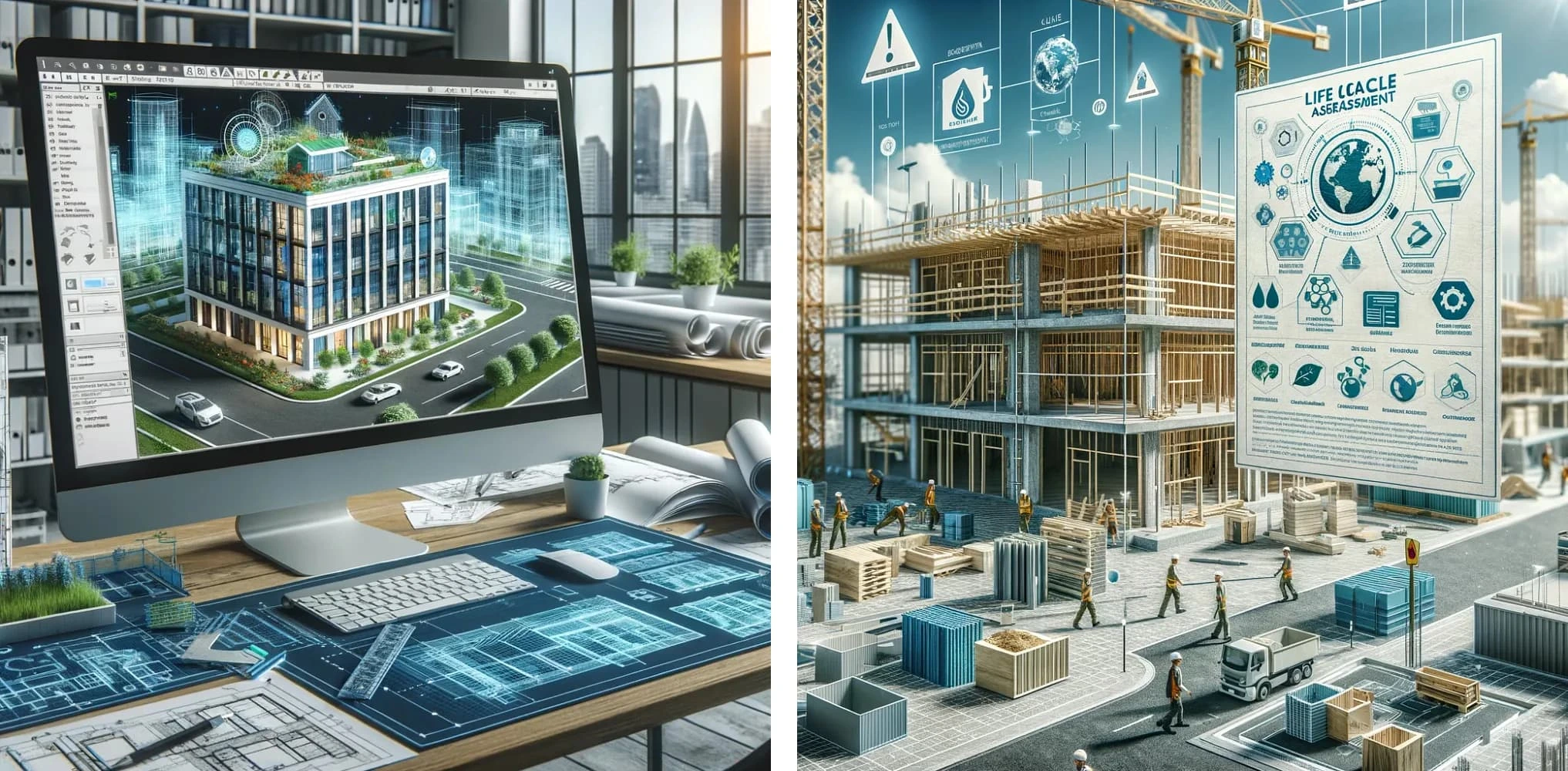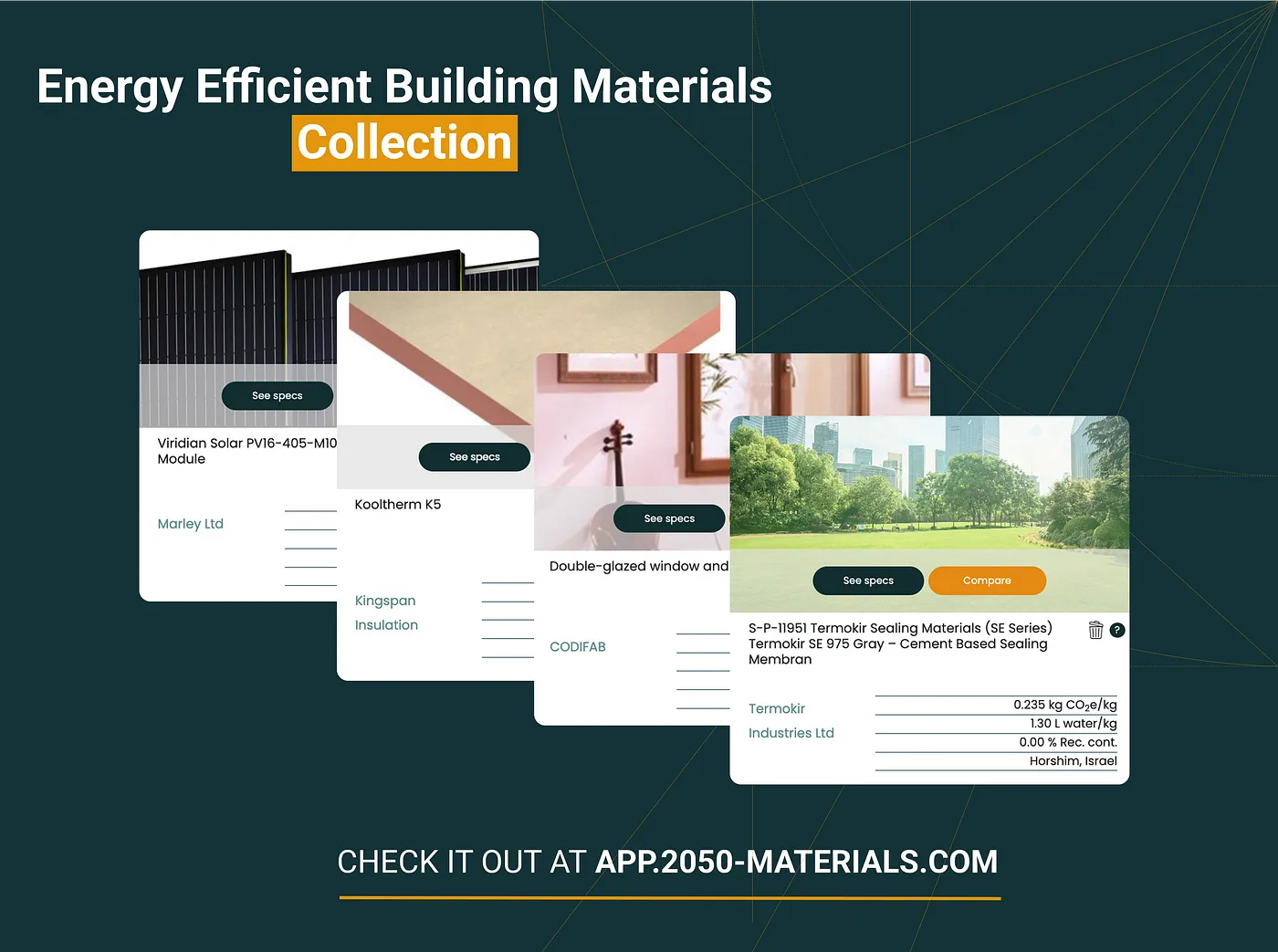LCA and BIM: Pioneering Sustainable Building Practices
Introduction
In the realm of sustainable construction, Life Cycle Assessment (LCA) and Building Information Modeling (BIM) are increasingly recognized as pivotal technologies. Their integration heralds a new era of eco-friendly and efficient building designs, offering transformative potential for the construction industry. This comprehensive exploration examines the synergistic relationship between LCA and BIM, underscoring their collective impact on shaping a sustainable future in construction.

Understanding LCA in the Context of BIM Life Cycle Assessment (LCA) extends beyond a simple environmental review, providing a comprehensive analysis of the ecological footprint throughout a product’s lifecycle. When merged with Building Information Modeling (BIM), which digitally encapsulates the physical and functional characteristics of a facility, LCA transforms into a dynamic tool, elevating the sustainability quotient in construction projects.
The Evolution of BIM in Sustainable Construction Tracing back to its inception, BIM’s journey has been marked by significant milestones. From a basic tool to enhance design efficiency, BIM has grown into an integral component of sustainable building design. Its detailed insights into construction materials and processes render it invaluable in meeting eco-friendly building standards and regulations.
🤝 Synergy of LCA and BIM
In our exploration, the robust support BIM provides to LCA, particularly in aligning model-based LCA with international standards and norms, stands out. This synergy is essential for detailed environmental impact assessments in construction, allowing for a more holistic approach to sustainable building practices.

From a digital model to a real building, LCA and BIM can be a real driver of sustainable construction.
📚 Theory & Practice
Venturing into the essentials of LCA and BIM, we emphasize the importance of detailed considerations such as the volume per element and material properties. By adhering to standards and embracing comprehensive theoretical knowledge, we can translate these insights into practical applications, significantly elevating the accuracy and sustainability of construction practices.
How It Works (In Theory)
The theoretical framework of LCA and BIM integration involves a detailed analysis of volume per element and material properties, including density and carbon indicator. This approach allows for the consideration of elements often overlooked in traditional modeling, such as rebar or finishes, and accounts for life expectancy as per national norms.
Challenges in Integration
The integration faces challenges related to the intricacies of data management, including uncertainties in both environmental indicators and the Bill of Material. Additionally, the complexities of model detail, data representation methods, and accurate material data representation present significant hurdles.
Workflows and Approaches
Diverse workflows and methodologies are available for different stages of LCA integration in BIM, each tailored to specific project need. Understanding and selecting the appropriate workflow is key to achieving sustainable outcomes.
Classic Manual Process
The classic manual process involves gathering necessary documents, manually generating bills of quantities, and calculating material weights to estimate environmental impact. This process, often conducted in Excel, lays the groundwork for detailed LCA analysis.
Semi-Automatic and Fully Automated Processes
Semi-automatic processes streamline LCA integration by generating bills of quantities from BIM software and matching materials with environmental indicators from database. Fully automated processes further reduce manual input, increasing efficiency and allowing for “instant” LCA during planning stage.
Most Common Approaches
Various common approaches include the use of Excel-based Bill of Materials, plugins for Revit/Archicad, and open-source solutions like IfcOpenShell and BlenderBIM LCAx, highlighting the need for BIM compatibility and interoperability
Python and Machine Learning in LCA and BIM
Python scripting, using libraries like IfcOpenShell, facilitates the extraction of volumes and other data from IFC file. Machine learning, including tools like OpenAI’s large language models, can calculate LCA from uploaded bills of quantities and offer various visualization and optimization suggestion.
💡Tackling Challenges
The integration of BIM with LCA, while beneficial, is accompanied by complexities. These challenges, including data compatibility and the intricate process of blending detailed BIM data with LCA requirements, need addressing. Solutions to these challenges are critical in achieving a seamless and efficient integration that bolsters sustainable construction efforts.
🌟 Empowering the Leaders of Tomorrow
The enthusiasm and commitment of students towards sustainable construction methodologies are heartening. Educating the next generation of construction professionals about the combined potential of LCA and BIM not only prepares them for future challenges but also ensures the continued evolution and sustainability of the construction industry.
Benefits of Integrating LCA with BIM
The convergence of LCA and BIM brings forth a myriad of benefits, revolutionizing the way we approach construction projects:
- Holistic Environmental Assessment: By integrating LCA’s comprehensive environmental analysis with BIM’s detailed project data, we achieve a more complete understanding of a building’s ecological impact.
- Streamlined Project Execution: The combination enhances project efficiency, reducing time and cost overruns by facilitating better-informed decision-making and planning.
- Enhanced Material Optimization: It enables more effective material selection and usage, minimizing waste and maximizing sustainability.
Challenges in the Adoption of LCA and BIM Despite these benefits, the adoption of LCA and BIM integration faces several hurdles:
- Interoperability of Systems: Ensuring seamless communication and data exchange between different software and platforms used in LCA and BIM.
- Upskilling and Training: The necessity for continual learning and adaptation among professionals to keep pace with technological advancements in both fields.
- Investment in Technology: The initial investment required for integrating sophisticated LCA and BIM systems can be significant, posing a challenge for smaller firms and projects.
Future Trends in LCA and BIM
Looking ahead, the integration of LCA and BIM is poised to become more streamlined and user-friendly. We anticipate advancements in AI and machine learning to further refine these tools, making them more accessible and effective. Additionally, the growing global emphasis on sustainability is likely to catalyze further innovations, paving the way for automated and more comprehensive LCA-BIM integration strategies.
Examples of Tools Integrating LCA within BIM
The landscape of tools integrating LCA within BIM is rapidly evolving, with several notable solutions leading the charge:
- EcoDesigner Star: This tool goes beyond traditional BIM capabilities, offering advanced energy modeling that is crucial for sustainable building design.
- Tally: A revolutionary Revit plugin, Tally allows architects and engineers to perform real-time life cycle assessments, making sustainable decision-making more integrated and efficient.
- One Click LCA: A game-changer in the industry, this tool simplifies the integration of LCA into BIM workflows, making sustainable design accessible and manageable.
These tools exemplify the potential of combining LCA and BIM, providing practical solutions for architects, engineers, and construction professionals committed to sustainable building practices.
LCA and BIM in Green Building Standards
The role of LCA and BIM in achieving green building certifications such as LEED, BREEAM, and DGNB cannot be overstated. These integrations provide a robust framework for meeting and exceeding the requirements of these certifications, ensuring that buildings are not only designed but also operated and maintained sustainably.
Energy Efficiency and Cost Savings with LCA and BIM
The integration of LCA and BIM is a powerful catalyst for energy efficiency in buildings. By enabling detailed analyses of energy use and environmental impact throughout a building’s life cycle, these tools help in creating designs that are not only cost-effective in the long term but also have significantly reduced carbon footprints.
Digital Twin Technology and Its Role with LCA and BIM
The advent of digital twin technology marks a significant advancement in the capabilities of LCA and BIM. By mirroring physical assets in a digital format, digital twins provide invaluable insights through real-time data and analytics. This integration enhances sustainable building management by allowing for more responsive and adaptive strategies.
LCA and BIM in Academic Research
The academic world plays a crucial role in the development of LCA and BIM integration. Research institutions worldwide are delving into new methodologies, constantly pushing the boundaries of what’s possible in sustainable construction. This research is not only crucial for technological advancement but also for preparing the next generation of professionals equipped with cutting-edge knowledge and skills.
Global Adoption of LCA and BIM
Globally, the adoption of LCA and BIM varies significantly, reflecting the diverse challenges and opportunities across different regions. Countries like Finland and Singapore are at the forefront, integrating these methodologies into national standards and construction practices. This global perspective is crucial in understanding the full potential of LCA and BIM, offering lessons and inspiration for broader implementation.
The Role of Government and Regulations in LCA and BIM
Governments worldwide are increasingly recognizing the importance of LCA and BIM in construction. Through regulations and incentives, they are encouraging the adoption of these methodologies, recognizing their potential in achieving national and international sustainability goals. Such initiatives are pivotal in driving the construction industry towards a more sustainable future.
Public Perception and Awareness of LCA and BIM
Public perception and awareness significantly influence the construction industry’s shift toward sustainable practices. As awareness of environmental issues grows, so does the demand for buildings that are not only aesthetically pleasing but also sustainable. This shift in public sentiment is a powerful driver for the adoption of LCA and BIM in construction projects.
Sustainable Material Selection Through LCA and BIM
One of the most significant impacts of integrating LCA and BIM is in the realm of material selection. By providing detailed insights into the environmental impact of different materials, these tools enable architects and engineers to make more informed decisions, choosing materials that are sustainable, durable, and suitable for specific project needs.
Carbon Footprint Reduction Strategies in Construction
Reducing the carbon footprint of construction projects is a critical goal of integrating LCA and BIM. By offering comprehensive analyses of materials and construction processes, these tools enable the development of strategies that minimize environmental impact, contributing significantly to the fight against climate change.
Collaboration and Communication: LCA and BIM’s Impact
The integration of LCA and BIM enhances collaboration and communication among all stakeholders in a construction project. By providing a unified platform for information sharing, these tools ensure that everyone involved in a project is on the same page, leading to more cohesive project management and execution.
Conclusion and Future Outlook

As we look to the future, the integration of LCA and BIM stands as a testament to the construction industry’s commitment to sustainability. With ongoing advancements and increasing adoption, these methodologies are set to play a pivotal role in reducing the environmental impact of the construction industry. The journey towards a more sustainable and environmentally responsible building industry is well underway, and the combined power of LCA and BIM is leading the charge.
Take the Next Step in Sustainable Construction with 2050 Materials
As you’ve seen in our exploration of the powerful integration of LCA and BIM, the journey towards truly sustainable construction practices is both innovative and necessary. If you’re ready to revolutionize your building projects by integrating comprehensive sustainability and LCA data into your BIM workflows, 2050 Materials is here to guide you. Our expertise in eco-friendly building solutions and advanced digital tools will empower your projects with the precision and sustainability they deserve. Don’t let the complexities of LCA and BIM integration slow you down.
Contact our team at 2050 Materials today, and take a significant step forward in building a more sustainable future. Let’s create eco-efficient buildings together, with every detail meticulously planned for minimal environmental impact.
Access our API to introduce LCA data in your BIM process.
Sources
This article was based on this initial post by Louis Trümpler and expanded to cover the details we see in our work at 2050 Materials.
Related articles

The Most Interesting Low Carbon Products in Office Design
In this article and collection, we highlight 11 outstanding products that contribute to a lower carbon footprint in office design.
Read more
Top Low Carbon Building Boards: Performance, Benefits, and Use Cases
The building boards highlighted in this article and collection showcase low-carbon innovation in modern construction.
Read more
11 Interesting Energy Efficient Building Materials for Reduced Environmental Impact
Discover a collection of energy efficient building materials that not only reduce greenhouse gas emissions but also contribute to long-term durability.
Read more